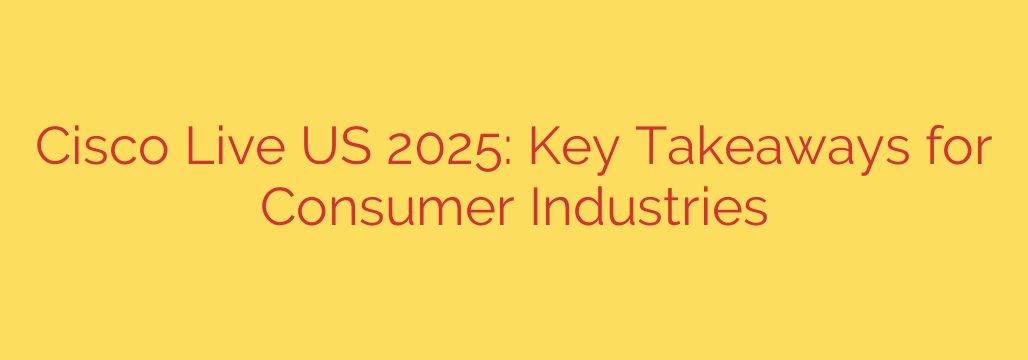
Navigating the Future: Key Technology Trends Shaping the Consumer Industry in 2025 and Beyond
The consumer landscape—encompassing retail, hospitality, and consumer packaged goods (CPG)—is in a state of constant evolution. Customer expectations are at an all-time high, supply chains are more complex than ever, and the line between digital and physical experiences has all but disappeared. To not only survive but thrive, businesses must embrace the technological shifts that are defining the future.
Recent industry insights reveal a clear roadmap for 2025 and beyond, centered on the powerful convergence of artificial intelligence, unified security, and intelligent, predictive networking. Here are the essential takeaways every leader in the consumer industry needs to understand.
The AI Revolution: From Personalization to Operational Excellence
Artificial intelligence is no longer a futuristic concept; it’s a foundational business tool. The next wave of AI is moving beyond simple chatbots and into every facet of the consumer journey and back-end operations.
The most significant shift is toward proactive, predictive capabilities. Generative AI is set to transform customer interactions, offering hyper-personalized recommendations, dynamic pricing, and support that feels genuinely human and helpful. Imagine a retail app that doesn’t just show you products you might like but helps you build an entire outfit based on your past purchases, current trends, and even the weather in your location.
Beyond the front end, AI-driven analytics are crucial for unlocking real-time insights from the vast amounts of data generated by stores, websites, and supply chains. This allows businesses to optimize inventory, predict demand with greater accuracy, and streamline warehouse operations, cutting costs and improving efficiency.
Redefining Security with a Unified, AI-Powered Approach
As consumer businesses digitize, their attack surface expands dramatically. Every point-of-sale system, IoT sensor in a warehouse, and employee device is a potential entry point for threats. The old approach of using a patchwork of disconnected security products is no longer viable.
The future of cybersecurity lies in a unified, platform-based strategy. The move towards a unified security platform is essential to close the visibility gaps between disparate security tools. By integrating security across the network, cloud, applications, and endpoints, businesses gain a single, comprehensive view of their entire environment.
This unified approach is enhanced by AI, which can analyze threat data from millions of sources to detect and respond to attacks faster than human teams ever could.
Actionable Security Tip: Adopt a Zero Trust mindset. This security model operates on the principle of “never trust, always verify,” meaning that no user or device is trusted by default, whether inside or outside the network. Implementing multi-factor authentication (MFA) and micro-segmentation are critical first steps toward building a Zero Trust architecture.
Intelligent Networking: The Foundation for Modern Experiences
The network is the central nervous system of any modern consumer business. It connects everything from the customer’s smartphone to the cloud applications running the business. A slow or unreliable network directly translates to a poor customer experience and lost revenue.
The focus is shifting from reactive network management to proactive, predictive networking. Predictive networking, powered by AI, can anticipate and resolve issues before they impact customer experience or business operations. Using advanced analytics, these intelligent networks can identify a degrading Wi-Fi signal in a store or a bottleneck in the supply chain network and automatically reroute traffic or alert IT teams.
This high-performance foundation is critical for enabling innovations like frictionless checkout, augmented reality (AR) shopping experiences, and reliable connectivity for back-of-house operations.
Full-Stack Observability: Seeing the Complete Digital Picture
In today’s complex digital ecosystem, when a customer has a poor experience with a mobile app or website, pinpointing the cause can be incredibly difficult. Is it a problem with the app code, the cloud infrastructure, an API, or the network itself?
This is where full-stack observability becomes a game-changer. It goes beyond traditional monitoring to provide a complete, correlated view of performance across the entire technology stack. Full-stack observability provides end-to-end visibility, from the moment a customer taps their screen to the backend database query that serves them content.
This holistic view allows IT teams to rapidly identify and resolve performance issues, ensuring a seamless digital experience that builds customer loyalty and protects the bottom line.
Actionable Tip: Start by mapping your most critical customer journeys—such as browsing a product, adding to cart, and checking out. Identify every application, service, and piece of infrastructure that supports that journey. This map will reveal where you have visibility gaps and where observability tools can provide the most immediate value.
In conclusion, the path forward for the consumer industry is clear. Success depends on building a business on an intelligent, secure, and resilient technology foundation. By strategically investing in AI, unified security, predictive networking, and full-stack observability, organizations can create the exceptional experiences customers demand and unlock new levels of operational efficiency.
Source: https://feedpress.me/link/23532/17097128/highlights-for-consumer-industries-from-cisco-live-us-2025








